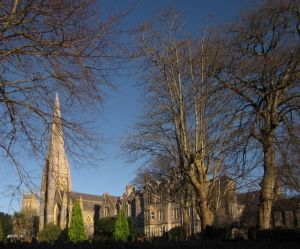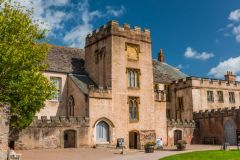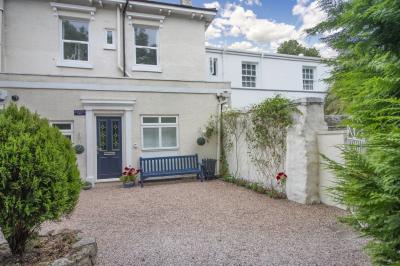
Many of the houses of Torquay were built as 'villas' for naval officers and families, and these villas are one of the most notable aspects of Torquay today. A few miles away is the showcave of Kent's Cavern, the scene of some of the earliest inhabitation in Britain. Torquay Museum tells the story of the area.
Babbacombe Cliff Railway
Built in 1926, the famous cliff railway takes visitors to and from the popular Oddicombe Beach. The railway takes visitors through breathtaking scenery as it descends to the water's edge, where there is a modern visitor centre and the chance to spot seals and dolphins offshore.
Babbacombe Model Village
One of the most popular visitor attractions in Torquay is this model village, the largest in Britain. There are thousands of miniature buildings, together with animated scenes, lit by thousands of miniature lights including working streetlights and car headlights. You can see inside many of the buildings.
Unlike some model villages, this is not meant to portray the locale of Torquay, but incorporates scenes from across Britain, both real and imagined. For example, you can see a miniature Stonehenge, a model of The Shard in London, and even a scene from the EastEnders TV series.
St Mary's Church
In the northern part of Torquay is St Marychurch, which takes its name from the Saxon church of St Mary. The present building is the fourth on the site, but it retains an early Norman font. The church was struck by a bomb in 1943 when 3 Sunday school teachers and 21 children were killed. The church was rebuilt and reconsecrated in 1956.
Torquay Museum
On Babbacombe Road stands this museum of local heritage, housed in an attractive Victorian building. One of the highlights is a gallery dedicated to writer Agatha Christie. See a reconstructed Devon farmhouse, prehistoric artefacts discovered at Kent's Cavern, and a special collection of Egyptian finds, including the mummified skeleton of a young boy from 500 BC.
Kents Cavern
Incongruously in the centre of Torquay (or, more accurately, under it) lies this cave system, formed in the early Pleistocene period by the action of water. The caves have revealed a wealth of archaeological remains as well as stunning geological rock formations. Curiously, the cave was once used as a workshop by a carpenter making bathing huts for the beach. Agatha Christie used Kent's Cavern as the model for Hempsley Cavern in her novel The Man in the Brown Suit.
Agatha Christie Mile
A heritage walk with a difference, the Agatha Christie Mile links the Grand Hotel and the Imperial Hotel, with 7 plaques along the course of the walk highlighting key events in the famous crime writer's life. Places along the Walk include the Grand Hotel, where Christie spent her honeymoon night in 1914, and Torre Abbey Gardens, with its special Potent Plants collection inspired by poisons used in Christie's books.
Another location is the Pavilion, where Archie Christie proposed to Agatha Miller, and Beacon Cove, where she almost drowned while swimming. You can pick up a free leaflet about the Walk from the visitor centre, and guided tours can also be arranged.
Torre Abbey
Torquay's oldest building is Torre Abbey, founded as a monastery in 1196. After the Dissolution of the Monasteries, the former monastic site was reused to build an elegant stately home for the Cary family. In 1930 the local council purchased the house for a public art gallery and made the grounds into a country park. Among the items on show are mementoes of writer Agatha Christie.
Beside the house is the Spanish Barn, so named because it was used to house 397 Spanish prisoners from the Spanish Armada. The prisoners were soldiers and crew from the galleon Nuestra Senora del Rosario, the only vessel captured during the Armada invasion. In the garden is a glasshouse with tropical and desert plants.
Cockington Court
Outside Torquay is the picturesque village of Cockington, where you will find Cockington Court, a mansion built by the Mallock family in the 16th century, over the ruins of a medieval house. A craft centre now occupies part of the estate buildings. The Court grounds are now a popular country park.







 We've 'tagged' this attraction information to help you find related historic attractions and learn more about major time periods mentioned.
We've 'tagged' this attraction information to help you find related historic attractions and learn more about major time periods mentioned.




